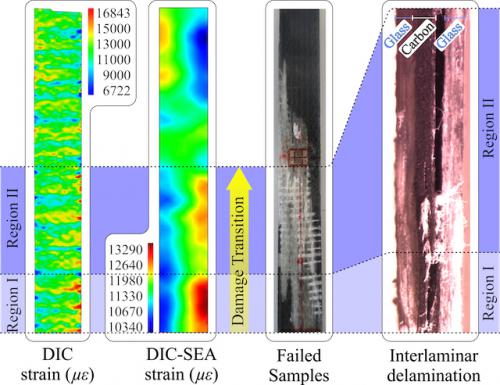
|
Experimental and Numerical Investigations on Fracture Mechanics of Composites
Additionally, we have thoroughly scrutinized the role of Halloysite nanotubes (HNTs) on the physics behind the deformation mechanisms and damage development in carbon fibre-reinforced polymer (CFRP) composites by using multi-instrument measurement and peridynamics. The nanotubes prevent the coalescence of microcracks by blocking crack propagation or diverting its path. Figure 2 presents an experimental-numerical mental image of this scenario, showing the hindrance of crack growth, crack tip splitting, and prevention of crack coalescence by HNTs clusters. In addition to experiments, by employing PD theory, we have purely numerically investigated that the branching and deflecting behaviour of macro (main) cracks in presence of multiple number of micro-cracks at the vicinity of the crack tip.
In our investigation on thick hybrid carbon/glass composites depicted in Figure 2, compressive stresses accumulate under the loading tip during flexural tests, thus triggering fibre micro-buckling (or kinking) and/or matrix yielding in the critical failure region. These kink band formations result in onset of transverse cracks, thereby leading to delamination at plies closer to the mid-plane of the specimen. Besides, as sketched in SEM micrograph and DIC graphs, the kink band formation at the top layer is more prominent in specimens containing carbon plies on the faces due to the low compressive strength of carbon fibres. Additionally, mode-II delamination initiation is observed in the 3C specimen due to shearing forces. Further, the macro damage is triggered by matrix cracking and subsequent delamination onset in the carbon layer of the 2C sample according fractography/DIC results.
Figure 2. Micro-to-macro crack damage transition in hybrid composites |
- Education
- Research
- Research Areas
- Advanced Mechanics of Composite Structures
- Automotive Systems
- Biomechatronics
- Biomedical Applications
- Design of Mechatronic Systems
- Dynamics and Vibration
- Energy Systems
- Experimental and Computational Micro/Nano Fluidics and Heat Transfer
- Real-Time Imaging and Machine Vision Systems
- Robotics, Systems and Controls
- Shape Sensing and Structural Health Monitoring
- Tissue Engineering
- Topology Optimization of Materials and Structures
- Labs & Research Groups
- Publications
- Projects
- Research Videos
- Research Areas
- People
- Information
- Contact
-





